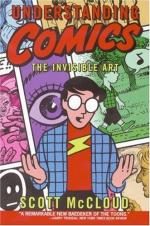
|
| Name: _________________________ | Period: ___________________ |
This quiz consists of 5 multiple choice and 5 short answer questions through Chapter 9, Putting It All Together.
Multiple Choice Questions
1. In a panel with a lot of action, such as the one on page 95, each figure is arranged sequentially and the audience will read them left to right. This could be argued as fitting the definition of _______.
(a) cartoons
(b) panels
(c) comics
(d) gutters
2. How does McCloud loosely define cartooning?
(a) A form of compression through complication
(b) A form of amplification through simplification
(c) A form of compression through simplification
(d) A form of amplification through complication
3. Which pair of words does not relate to each other, in terms of comic style?
(a) Realistic; iconic
(b) Famous; anonymous
(c) Objective; subjective
(d) Complex; simple
4. The order and emphasis of which two steps demonstrates the most dramatic difference?
(a) Idiom and idea/purpose
(b) Form and idea/purpose
(c) Form and structure
(d) Idiom and Form
5. What is typically the third most common type of transition in the most storytelling technique used in comics?
(a) Moment-to-moment
(b) Action-to-action
(c) Scene-to-scene
(d) Subject-to-subject
Short Answer Questions
1. What type of magazine kept comics alive before the 20th century?
2. What object is painted in "The Treachery of Images?"
3. Comics relay on _____ sense(s) to convey a world of experience.
4. Which country's artists widely adopted photographic trickery such as blurring and streaking soon after its inception?
5. What is typically the second most common type of transition in the most storytelling technique used in comics?
|
This section contains 236 words (approx. 1 page at 300 words per page) |

|




